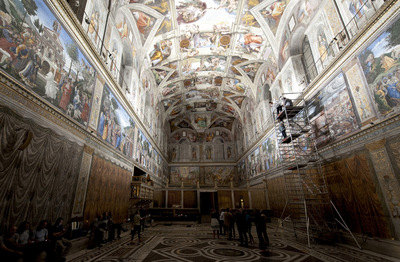Osram retrofits lighting at the Sistine Chapel
Tuesday, 03 December, 2013
Multinational lighting manufacturer Osram is set to retrofit lighting at the Sistine Chapel in Rome, Italy. The art-conserving installation is expected to enable significantly higher illuminance values and consume 60% less power compared to the existing lighting installation.
Osram will install around 7000 LEDs at the Sistine Chapel. The colour spectrum has been custom-adapted on a scientific basis and with high precision to the colour pigments of the paintings; for example, to the pigments in the Michelangelo frescoes. The luminaires will be installed away from view below the windows to make sure that light is emitted in the same direction as the natural daylight. Until now, the art could only be seen according to the ingress of daylight, and the view was limited by technological and conservational constraints. The conservational aspect played a particularly important role during the planning of the project.

Illuminance of approximately 50 to 100 lux (previously 5 to 10 lux) ensures that the art can be clearly discerned, but with as little ageing as possible. In addition to the quality of the lighting, the new solution is said to be significantly more economical than the previous system. Although the level of brightness can be increased, the power consumption is expected to be reduced by more than 60%. The savings are due to the efficiency of LEDs and the highly exact light planning that illuminates the chapel with high precision and without light spill.
This pilot project, with the working title of LED4Art, is subsidised by the European Subsidy Program for Information and Communication Technology within the Framework Program on Competitiveness and Innovation (PSP-CIP). The aim of the subsidy program is to demonstrate new possibilities for LED technology with regard to energy efficiency and improved quality of light, and thus to achieve more rapid market penetration for the new technology. In addition to the project coordinator Osram, other partners involved are the University of Pannonia in Hungary, the Institut de Recerca en Energia de Catalunya in Spain and the planning offices of Faber Technica in Italy.
Tackling EV misinformation at Everything Electric
Lauren Davis discusses all things EV with Robert Llewellyn, Red Dwarf cast member...
Let's talk about electrification, digitalisation and decarbonisation
Can the building sector use AI tools as a binding force for different energy efficiency processes?
A connected world: how smart systems are enhancing sustainability
The drive for smarter, smoother, more efficient connected and integrated infrastructure is often...




